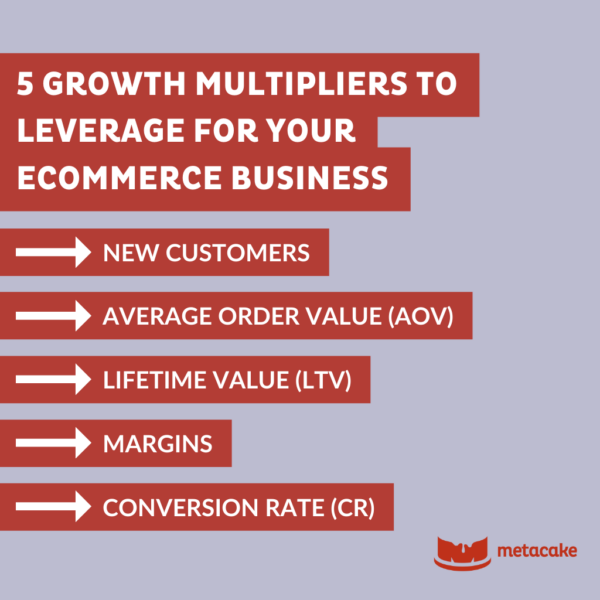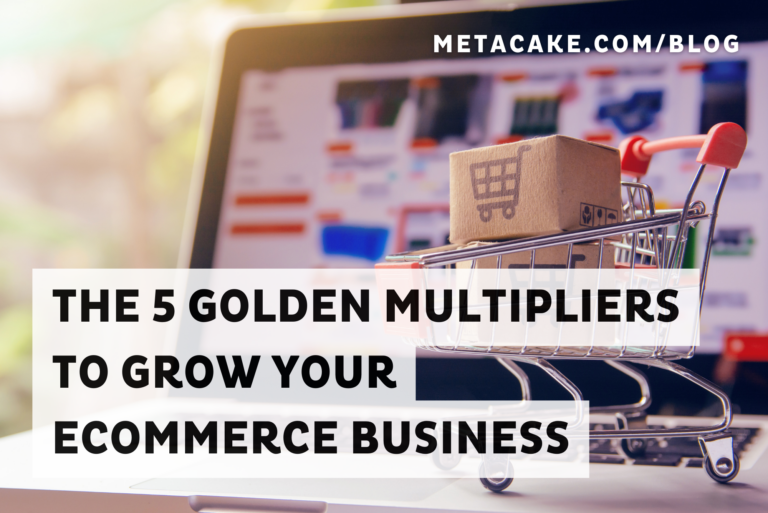There’s no doubt about it: business is complex. But we also see ecommerce business owners overcomplicate it all the time, which leads to overwhelm and ineffective decision-making.
When you get down to it, any business model that functions is just a few metrics that work well together under the hood.
Jay Abraham is known for identifying 3 basic levers you have to master for any business to grow exponentially:
- Increase number of customers
- Increase average price per purchase
- Increase frequency of purchases per customer
This list translates directly to ecommerce and is the primary way we seek to grow ecommerce businesses. We even throw a couple of additional simple levers into the equation.
Below, we outline five simple growth multipliers (or metrics) ecommerce brands can leverage and how to use them.

5 Growth Multipliers to Leverage for Your Ecommerce Business
Let’s walk through each of these growth multipliers, explain how to use them, and explore what they can do for your business.
Growth Multiplier 1: New Customers
Definition: The number of new people coming into your ecosystem in a given period.
Why is this critical for growth? New customers are obviously how you expand your brand’s influence and sales. Acquiring new customers is where business owners focus, but it shouldn’t be the only focus. While a steady flow of new customers provides linear growth, it doesn’t bring exponential growth. That comes from working on the other growth multipliers.
How do you measure this growth multiplier? The number of new customers acquired per week, month, or year.
How do you grow this area? The first step is obvious: Make sure you have a great product and a strong offer. Next, market that product. Remember, you need to pay for traffic somehow to acquire new customers. Additionally, capture as many email addresses from site visitors as possible, even if they don’t purchase (and most won’t). Use automated email sequences to follow up with those names, helping them get to know your brand until they are ready to purchase.
Growth Multiplier 2: Average Order Value (AOV)
Definition: The average price per unique order
Why is this critical for growth? Increasing your store’s average order value is critical for supporting your new customer acquisition costs. The larger your orders, the more you can afford to spend on acquiring more customers. It’s tough to identify a benchmark average order value because every business is different, but in our opinion, it should be over $60 for most businesses.
How do you measure this growth multiplier? This is a simple metric to calculate (revenue / number of orders) and is usually readily available on any store platform.
How do you grow this area? There are a few ways to help increase your average order value:
- The root of a high average order value comes from having a strong product line strategy. Your ecommerce store needs to have a variety of products that a customer can identify a reason to purchase; the site shouldn’t be a one-hit wonder.
- A good tactic for increasing AOV is utilizing up-sells and cross-sells. For more on this, check out How to Optimize Your Upsells or The Upsell Strategy That Converts Like Crazy.
- As mentioned above, you need to have a great offer. Price plays a part in this, but a great offer is all-encompassing and has more to do with the messaging and proposition of your product and its value than giving a nice discount.
Growth Multiplier 3: Lifetime Value (LTV)
Definition: Lifetime value measures the amount a customer spends with a company throughout their relationship with that company. However, it’s usually more useful to look at a period of 30, 60, or 90 days, or possibly 1 year, to calculate this value.
Why is this critical for growth? LTV is key for exponential business growth. Most businesses lose money on the initial sale, primarily due to advertising costs to get the visitor to the site; just breaking even is fantastic. The way your business wins is by bringing the customer into your ecosystem and encouraging them to purchase again and again.
How do you measure this growth multiplier? Measuring customer lifetime value first requires identifying what period of time makes the most sense for your customer life cycle. From there, you can use a simple equation involving average order value and average order frequency. Check out our post How to Grow The Lifetime Value of Your Ecommerce Customers for that simple equation, or take a look at this post from Shopify for more in-depth info on lifetime value.
How do you grow this area? Growing lifetime value has a few layers to it, including:
- Product line strategy: As mentioned pertaining to AOV, your ecommerce business needs a product line strategy that allows customers to purchase again and again. Either your product is something that needs to be bought monthly or a few times a year, or you have a variety of products to choose from to keep customers coming back.
- Email / communication strategy: You’ll also need a strong email marketing strategy to nurture the relationship with your customers, reminding them of when it might be time to re-order, educating them on other products you offer, and keeping them in the loop about sales and new product releases.
- Fan creation: The best way to increase lifetime value is to create not just customers but brand fans. These are the evangelists who rave about you to their friends, talk about you on social media, and buy from you again and again. Certain tactics can accomplish this, which we dive into in The Holy Grail of Ecommerce Success: Creating Lifelong Brand Fans.
Growth Multiplier 4: Margins
Definition: Your product margin is the amount of money built into your products’ prices that’s left over after pulling out your hard costs. Margin isn’t the same as profit, but it contributes to it.
Why is this critical for growth? If your margins are too low, your business won’t be able to operate in profit or invest in acquiring customers, providing outstanding customer service, and innovating with new products. Without all these elements, ecommerce businesses stall or fail. Margins are truly the fuel for your business rocketship.
With that in mind, we suggest a minimum 5x markup. However, ecommerce companies do best when margins are close to 10x markup, or even as high as 30x!
How do you measure this growth multiplier? You can measure margins by the percent markup on a product, or you can look at the percent markup as a weighted average of your best-selling products.
How do you grow this area? Be sure to consider product margins before you start your business. It’s harder to grow your margins once you’re already established. If you do, it often means reducing product quality, which isn’t great. If you’re an established brand, the best way to grow your product margin is to consider it as you develop new products alongside your existing ones.
Growth Multiplier 5: Conversion Rate (CR)
Definition: Your ecommerce store’s conversion rate is the percentage of people who make a purchase vs. the total number of visitors on your site.
Why is this critical for growth? Most ecommerce business owners keep an eye on conversion rates, but because so many factors influence the number, it can feel difficult to do anything about. However, conversion rate is critical for growth and has enormous power when leveraged. In fact, it’s the largest growth multiplier because even a small increase in conversion rate increases everything else. Marketing spend goes further, you acquire more traffic for less cost, lifetime value increases, etc.
How do you measure this growth multiplier? You can easily measure conversion rate on any platform, and you can also find it in analytics tools like Google Analytics. The best way to measure conversion rate, though, is by looking at the number in segments, such as by device (mobile vs. desktop) or by marketing channel.
How do you grow this area? This is a compound metric, meaning other underlying metrics influence it. To grow it, therefore, you have to grow the contributing metrics and factors. That can include:
- Technical elements on your site
- Experiential factors such as site navigation, landing page or product page layout, etc.
- Your offer and value proposition
- Product and surrounding messaging
Leverage Your Growth Multipliers
Every business has its complexities, but if you focus on improving each of these growth multipliers by just 5%, it will compound into exponential growth. In fact, if you have a growth goal in mind, you can work backward from that goal to determine how much each factor needs to increase.
Once you have those specifics, you can create initiatives that contribute to achieving each objective.
